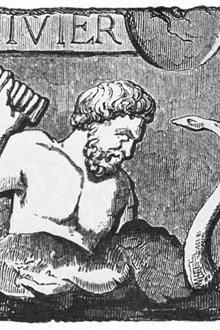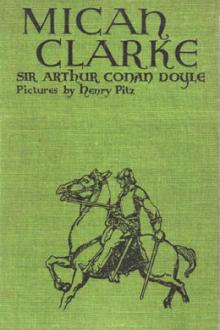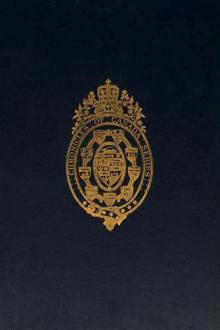Three Thousand Years of Mental Healing by George Barton Cutten (best large ereader txt) 📕

- Author: George Barton Cutten
- Performer: -
Book online «Three Thousand Years of Mental Healing by George Barton Cutten (best large ereader txt) 📕». Author George Barton Cutten
The Project Gutenberg eBook, Three Thousand Years of Mental Healing, by George Barton Cutten
almost no restrictions whatsoever. You may copy it, give it away or
re-use it under the terms of the Project Gutenberg License included
with this eBook or online at www.gutenberg.org
Title: Three Thousand Years of Mental Healing
Author: George Barton Cutten
Release Date: October 22, 2007 [eBook #23101]
Language: English
Character set encoding: ISO-8859-1
***START OF THE PROJECT GUTENBERG EBOOK THREE THOUSAND YEARS OF MENTAL HEALING***
E-text prepared by David Clarke, Turgut Dincer,
and the Project Gutenberg Online Distributed Proofreading Team
(http://www.pgdp.net)
THREE THOUSAND YEARS OF MENTAL HEALING
BY
GEORGE BARTON CUTTEN, Ph.D.
(YALE)
PRESIDENT OF ACADIA UNIVERSITY
ILLUSTRATED
NEW YORK
CHARLES SCRIBNER'S SONS
1911
BAS-RELIEF REPRESENTING THE GALLIC ÆSCULAPIUS
DISPATCHING A DEMON
THIS BOOK IS DEDICATED TO THE MEMORY
OF
Artemus Wyman Sawyer, D.D., LL.D.
PRESIDENT OF ACADIA UNIVERSITY
1869-1896
HE HID FROM US HIS HEART WHILE WE THOUGHT THAT HE LOVEDONLY HIS STUDIES; WE LATER LEARNED THAT HE LAID
EMPHASIS ON THAT WHICH HE LOVED ONLY LESS—TRUE
KNOWLEDGE, IN ORDER THAT HE MIGHT INTRODUCE
IT TO THOSE THAT HE LOVED MOST—HIS
PUPILS. HE TAUGHT AS NONE OTHER
CONTENTS CHAPTER PAGE I. Introduction—Mental Healing 3 II. Early Civilizations 19 III. The Influence of Christianity 35 IV. Relics and Shrines 61 V. Healers 110 VI. Talismans 138 VII. Amulets 158 VIII. Charms 189 IX. Royal Touch 224 X. Mesmer and After 249 XI. The Healers of the Nineteenth Century 273 Index 273 PREFACE
The present decade has experienced an intense interest in mental healing. This has come as a culmination of the development along these lines during the past half century. It has shown itself in the beginning of new religious sects with this as a, or the, fundamental tenet, in more wide-spread general movements, and in the scientific study and application of the principles underlying this form of therapeutics.
Many have been led astray because, being ignorant of the mental healing movements and vagaries of the past, the late applications, veiled in metaphysical or religious verbiage, have seemed to them to be new in origin and principle. No one could consider an historical survey of the subject and reasonably hold this opinion. It is on account of the ignorance of similar movements, millenniums old, that so much, if any, originality can be credited to the founders.
The object of this volume is to present a general view of mental healing, dealing more especially with the historical side of the subject. While this is divided topically, the topics are presented in a comparatively chronological order, and thereby trace the development of the subject to the present century.
The term "mental healing" is given the broadest possible use, and comprehends any cures which may be brought about by the effect of the mind over the body, regardless of whether the power back of the cure is supposed to be deity, demons, other human beings, or the individual mind of the patient.
It is hoped that this may contribute to the knowledge of a subject which is of such wide-spread popular interest.
George Barton Cutten.
Wolfville, Nova Scotia,
December 1, 1910.
dispatching a demon Frontispiece Facing
Page Cure through the Intercession of a Healing Saint 72 Valentine Greatrakes 134 Sir Kenelm Digby 152 King's Touch-pieces 226 F. A. Mesmer 232 John Alexander Dowie 276 George O. Barnes 290 Mary Baker Eddy 302 THREE THOUSAND YEARS OF MENTAL HEALING CHAPTER I INTRODUCTION—MENTAL HEALING
"'Tis painful thinking that corrodes our clay."—Armstrong.
"Oh, if I could once make a resolution, and determine to be well!"—Walderstein.
"The body and the mind are like a jerkin and a jerkin's lining, rumple the one and you rumple the other."—Sterne.
"I find, by experience, that the mind and the body are more than married, for they are most intimately united; and when the one suffers, the other sympathizes."—Chesterfield.
"Sublime is the dominion of the mind over the body, that for a time can make flesh and nerve impregnable, and string the sinews like steel, so that the weak become so mighty."—Stowe.
The fact that there is a reciprocal relation between mental states and bodily conditions, acting both for good and ill, is nothing new in human experience. Even among the most crude and unobserving, traditions and incidents have given witness to this knowledge. For centuries stories of the hair turning white during the night on account of fright or sorrow, the cause and cure of diseases through emotional disturbances, and death, usually directly by apoplexy, caused by anger, grief, or joy, have been current and generally accepted. On the other hand, irritability and moroseness caused by disordered organs of digestion, change of acumen or morals due to injury of the brain or nervous system, and insanity produced by bodily diseases, are also accepted proofs of the effect of the body on the mind.
Recent scientific investigation has been directed along the line of the influence of the mind over the body, and to that phase of this influence which deals with the cure rather than the cause of disease. In addition to what the scientists have done along this line, various religious cults have added the application of these principles to their other tenets and activities, or else have made this the chief corner-stone of a new structure. There are some reasons why this connection with religion should continue to exist, and why it has been a great help both to the building up of these particular sects and the healing of the bodies of those who combine religion with mental healing.
We must not forget that in early days the priest, the magician, and the physician were combined in one person, and that primitive religious notions are difficult to slough off. Shortly before the beginning of the Christian era there were some indications that healing was to be freed from the bondage of religion, but the influence of Jesus' healing upon Christians, and the overwhelming influence of Christianity upon the whole world, delayed this movement, so that it did not again become prominent until the sixteenth century. About this time, when therapeutics as a science began to shake off the shackles of religion and superstition, another startling innovation was noticeable, viz., the division of mental healing into religious and non-religious healing. This change came gradually, and as is usual in all reform, certain prophets saw and proclaimed the real truth which the people were not able to follow or receive for centuries.
Paracelsus, who lived during the first half of the sixteenth century, wrote these shrewd words: "Whether the object of your faith is real or false, you will nevertheless obtain the same effects. Thus, if I believe in St. Peter's statue as I would have believed in St. Peter himself, I will obtain the same effects that I would have obtained from St. Peter; but that is superstition. Faith, however, produces miracles, and whether it be true or false faith, it will always produce the same wonders." We have also this penetrating observation from Pierre Ponponazzi, of Milan, an author of the same century: "We can easily conceive the marvellous effects which confidence and imagination can produce, particularly when both qualities are reciprocal between the subject and the person who influences them. The cures attributed to the influence of certain relics are the effect of this imagination and confidence. Quacks and philosophers know that if the bones of any skeleton were put in the place of the saint's bones, the sick would none the less experience beneficial effects, if they believed they were near veritable relics."
What seemed to be a movement whereby mental healing should be divided so that only a portion of it should be connected with religion proved to be too far in advance of its time, and not until the advent of Mesmer was this accomplished. Healing other than mental, however, did obtain its freedom at this time. While Mesmer and his followers emphasized non-religious mental healing, it should not be thought that mental therapeutics was ever entirely separated from the church. There have always been found some sects which laid particular emphasis on it, and both Roman Catholic and Protestant orthodox Christianity have always admitted it. It has been considered, even if not admitted, that the power of the Infinite was more clearly shown by the healing of the body than by the restoration of the moral life. It is natural, then, that the sects which showed this special proof of God's presence and power would grow faster than their spiritual competitors, but that they would decline more rapidly and surely than those which espoused more spiritual doctrines.
On the other hand, it is not difficult to see why mental healing would be helped by its connection with religion. Religion grips the whole mind more firmly than any other subject has ever done, and when one accepts the orthodox conception of God, he naturally expects to come in contact with One whose sympathies are in favor of the cure of his diseases, and whose power is sufficient to bring about this cure. With this basis there is set up in the mind of the patient an expectancy which has always proven to be a most valuable precursor of a cure. The devout religious attitude of mind is one most favorable for the working of suggestion, and persons of the temperament adapted to the religious expression most valued in the past are those who could be most readily affected by mental means. For these reasons, it can be easily understood why mental healing has continued to be associated with religion, and why when thus associated it has been so successful.
To those not very familiar with mental healing, it has seemed strange that any law could be formulated which would comprehend every variety. In the following pages many different forms will be described, and in examining the subject it will be found that many and varied are the explanations given for the results produced. We find also a general distrust of all the others, or else a claim that this particular sect is the only real and true exponent of mental healing, and that it produces the only genuine cures. Those which claim to be Christian sects, however divergent the direct explanation of their results, give the final credit to God, and base their modus operandi upon the Bible —in fact, they claim to be the direct successors of Jesus and his disciples in this respect.
We find, however, that the healer connected with the Christian sect has no advantage over his Mohammedan or Buddhist brother, and that neither is able to succeed better than the non-religious healer in all cases. We recognize that when one class of healers fails in a case another may succeed, but the successful one is just as liable to fail in a second case when the first one cures. What particular form of suggestion is most effective in any





Comments (0)